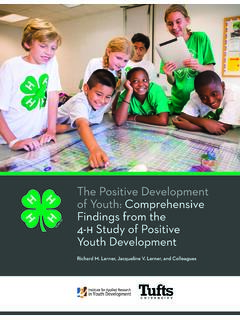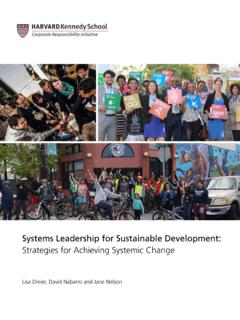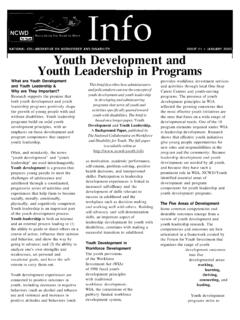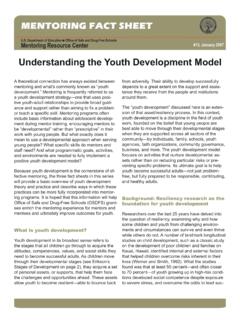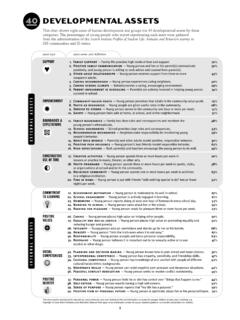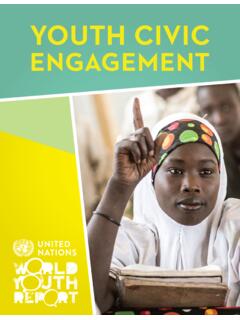Transcription of A Youth Justice System that Works for Children
1 A Youth Justice System that Works for Children A Joint Policy Position Paper by Service, Strategic and Political Leaders in Local Government November 2021 The Association of Directors of Children 's Services Ltd The Association of YOT Managers Local Government Association The Association of Directors of Children 's Services The Association of Directors of Children 's Services Ltd. (ADCS) is the national leadership organisation in England for directors of Children 's services (DCSs) under the provisions of the Children Act (2004). The DCS acts as a single point of leadership and accountability for services for Children and young people in a local area, including Children 's social care and education. The Association of YOT Managers The AYM (Association of YOT Managers) is a professional association representing the majority of Youth Offending Teams (YOT's)/ Youth Justice Services and their Managers in England.
2 Our members work within the Youth Justice sector and run services providing community-based supervision for Children and young people who offend and prevention services for those at risk of offending through a Child First' model of practice. We also work with Children in custody and liaise closely with staff in the Youth secure estate to ensure that Children and young people receiving custody experience as smooth a transition as possible, both within custody and their subsequent resettlement back in to the community. The Local Government Association The Local Government Association (LGA) is the national voice of local government. We work with councils to support, promote and improve local government. We are a politically-led, cross party organisation which Works on behalf of councils to ensure local government has a strong, credible voice with national government.
3 We aim to influence and set the political agenda on the issues that matter to councils so they are able to deliver local solutions to national problems. 1. 1. Executive summary In many ways recent Youth Justice policy can be considered a success story, with the reductions in cautions, convictions and overall contact with the Youth Justice System over the last decade or so rightly being described as startling (MoJ, 2016). However, these impressive headlines mask some very significant challenges in both policy and practice terms that require urgent attention, and crucially, action. From growing racial disparities and the over-representation of Children with special educational needs or who are in care to concerns about the sustainability of the highly successful preventative work undertaken by Youth offending teams (YOTs).
4 In early 2016, a shocking BBC Panorama investigation exposed bullying, aggressive staff behaviours and the use of inappropriate restraint on Children at Medway Secure Training Centre (STC). Since then, a series of reviews, inquiries and reports, many of which have been directly commissioned by government, have been undertaken. It is no exaggeration to say hundreds of recommendations for change have been put forward by independent reviewers, parliamentary select committees, the inspectorates, and others. The BBC. documentary, and the strength of public reaction to it, should have been a watershed moment, sadly it was not. Five years on many of the same issues remain or have worsened, with Covid-19 adding a new sense of urgency. Over the last two years the inspectorates have documented an alarming deterioration in conditions and performance of the Youth secure estate, with Medway and Rainsbrook STCs closing in the last 18 months following poor inspections.
5 In recent weeks, fresh concerns about the health, safety and wellbeing of the Children in the remaining STC in England, Oakhill, have resulted in the issuing of an Urgent Notification and a pause on new placements. As the cohort in conflict with the law has contracted, the Children now involved with the System have more complex and overlapping education, health and social care needs. Their offending behaviours often mask underlying vulnerabilities: from early childhood trauma and neglect to school exclusion, poor mental health and growing up in poverty. The severity and types of offences committed by Children have shifted; average custodial sentences are longer; and, levels of violence between Children , with staff and self-harm in custody are all high and rising. The pandemic has heightened existing concerns about the way Children in conflict with the law continue to be treated differently; including backlogs and delays in police investigations and in the courts; access to education in custodial settings; and, collective responses to criminal exploitation.
6 Action is urgently required, not further diagnosis. A redesign of the current Youth Justice arrangements is clearly required if we wish to pursue truly Child First' approaches whilst supporting the needs of victims and their families. There are several timely developments which could assist with this aim: from national reviews into special educational needs, Children 's social care and the passage of the new Police, Crime and Sentencing Bill to ongoing pandemic recovery planning. A series of changes to address gaps in existing guidance or practices are put forward here to bring about improvements to Children 's experiences and outcomes. These include: better sharing of information between the police and local authority YOTs, closer working between YOTs and Children 's social care and routinely applying rules on vulnerable witnesses to all Children appearing in Youth courts.
7 In the longer term, a more sophisticated, multi-agency, multi-disciplinary response is needed. This is best achieved via a cross-Whitehall public health response to Youth Justice and wider childhood vulnerabilities. 2. 2. Background how we got here In many ways recent Youth Justice policy can be considered a success story. For the first time, The Crime and Disorder Act 1998 established a functionally separate Youth criminal Justice System for 10 18-year-olds. Since then, sustained, co-ordinated efforts have, in the words of Charlie Taylor, who was charged with undertaking a wide-ranging review of the Youth Justice System , resulted in: startling achievements (MoJ, 2016). The number of Children cautioned with, or convicted of, committing a crime fell by three quarters between 2009 and 2019/20, while the number of 10 17-year-olds entering the Youth Justice System for the first time fell by 84% over the same period (YJB, 2021).
8 Indeed, by autumn 2021, fewer than 500 under 18s were in custody, down from 2,800 in 2008/09. However, these impressive headlines mask some very significant challenges in both policy and practice responses that require urgent attention and, crucially, action if we are to continue to divert more Children away from the System , whilst also ensuring it is safe and meets the needs of those who are already in contact with it. The nature of these challenges, including the over-representation of Children with special educational needs or in care to redressing the growing racial disparities in our criminal Justice System , have been well diagnosed, but still decisive action remains far too slow. A shocking BBC Panorama investigation aired in early 2016, exposing bullying, aggressive staff behaviours and the use of inappropriate restraint of Children at Medway Secure Training Centre (STC).
9 Since then, a series of reviews, inquiries and reports dealing wholly, or in part, with Youth custody and Children in conflict with the law have been undertaken. Many have been directly commissioned by government departments, or agencies, with strong common themes (see Appendix 1): Children 's experiences: Safety, including persistently high levels of violence and self-harm, in custody; the quality of education provision in custody; poor transitions to the community and to the adult estate Systemic issues: Poor governance and accountability; lengthening court delays;. slow progress on implementing agreed reforms secure schools; regulation and inspection being out of step with wider Children 's services; and, overrepresentation Policy issues: The absence of a strategic vision for Youth Justice ; the low age of criminal responsibility; funding; responses to Children who are criminally exploited.
10 Across these reports and drawing in the findings from the inspection of individual custodial settings by HMI Prisons, HMI Probation, the Care Quality Commission and Ofsted as well as several relevant thematic inspection reports published since 2016, hundreds of recommendations for change have been put forward to improve the responses to, and experiences and outcomes of, Children in conflict with the law. The BBC expos , and the strength of the public reaction to it, should have been a watershed moment, sadly it was not. Five years on, many of the same issues remain, or have worsened, with Covid-19 adding a new sense urgency. 3. The case for change - what's not working and why is now the time for change? A redesign of the current Youth Justice arrangements is clearly required if we truly want to pursue more child-centred approaches and take seriously the evidence from child and adolescent development .






